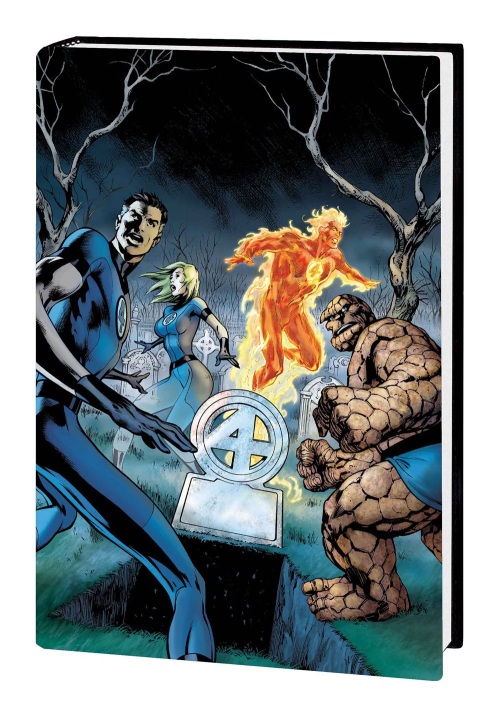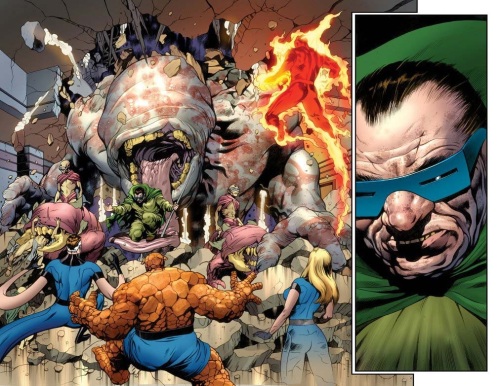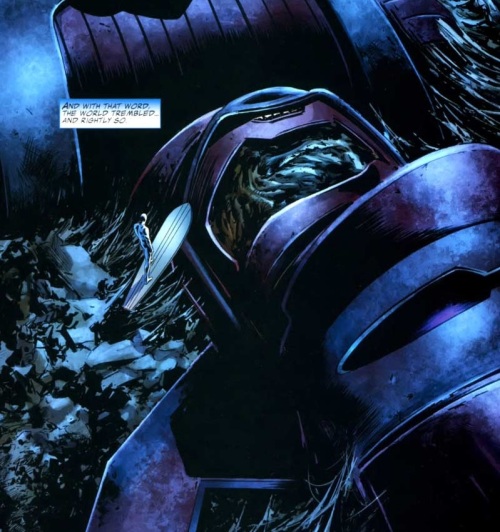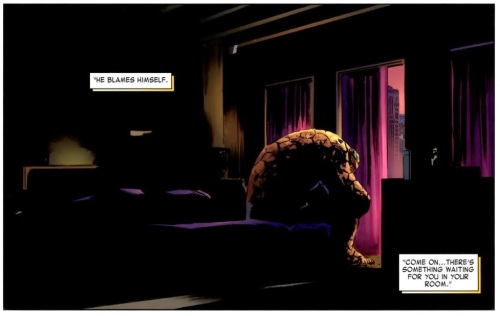
During Jonathan Hickman’s original 2009-12 tenure on Fantastic Four¸ everyone was raving about it. I was sceptical. I’d read them on and off, and they seemed generally great to look at but otherwise a bit of an unfinished muddle.
I was wrong.
The true beauty of Hickman’s style can’t be grasped in a few issues picked up intermittently. You need to have faith in the writer. This story is a long, but ultimately rewarding, one. He’s playing with the core foundations of the FF, and drawing threads throughout. This much should be evident from the very first storyline, The Bridge – not technically part of the main title, but essential if you’re to get to grips with why the following events take place.
It’s tied into Dark Reign, in which Norman Osborn is in charge of – well, essentially world security, and unlike many tie-ins, doesn’t suffer from this tether. There’s a heightened tension as Osborn and co. storm the Baxter Building, while the actual FF are otherwise engaged. That means it’s down to Franklin and Valeria, Reed and Sue’s children, to fend them off.
In order to do so, Valeria uses all her wits, and Franklin dresses like a cowboy.
The Bridge doesn’t entirely work as a narrative because it may be fun, but it also appears pretty pointless, at least what’s happening to Sue, Ben, and Johnny. Yet in hindsight, it sets up the rest of this omnibus surprisingly well. First off, we get to see how capable the kids are, and how they can be relied upon. Franklin may seem like he’s messing about, but you shouldn’t underestimate him. Valeria, meanwhile, is arguably smarter than her father. These two are absolute joys to read about, not just in The Bridge but in the omnibus as a whole.

Otherwise, there’s Reed’s hopelessness at facing the future, a major motivation throughout, and foreshadowing an uneasy feeling that all that’s about to happen is his fault, especially the direct consequences on the rest of his family.
After a brief interlude focusing on the secret intentions of both Namor and Dr Doom (both of whom get up to some interesting things later on in the book), we come to Idea #101: Solve Everything, also the title of the second storyline (or the debut of Hickman on the proper Fantastic Four series).
That the writer’s plans are ambitious should be immediately obvious. Reed meets the Council, an interfering bunch of arrogant know-it-alls with God complexes. They’re all Reed. That is, they’re all different versions of Mr Fantastic from alternating universes. It’s an exceptionally intriguing idea, one that ends by re-establishing a key part in FF lore: that each member is an oddity, but that their sense of family will always draw them back together.
Interestingly, it may seem that ‘our’ Reed proves himself a superior being because he can let the rest of the multiverse get on with whatever it’s doing, that he can leave behind his ambition to solve everything, to come back, as ever, to his loving family and friends. But it’s not all it appears: Reed is indulging in his own God complex, fulfilling that same desire through different means to be “a better man.” Needless to say, this isn’t fully wrapped up: the Council remains an undercurrent, as does Richards’ connection with his father.
This omnibus collects six graphic novels (the Dark Reign prelude, debut arc of FF aka the Future Foundation, and four of the core title), but it feels like more than that and, paradoxically, only one. That’s because it’s one ongoing narrative, separated into loose parts, and further segmented into chapters. Prime Elements, the third collection, sets up many principle ideas, but, let’s face it, is also a bit of a mess.

Certainly, if I’d have picked it up as a lone graphic novel, I would’ve been disappointed. It feels like samplers: small notional injections, not full explorations. They’re typically-single issues used to remind you of particular sections of the FF mythology.
They draw on the bases of the team, established by Stan Lee and Jack Kirby in those early years: Mole Man and Subterranea; Atlantis; the Inhumans; Annihilus and the Negative Zone; space exploration; and evolution. Hickman has looked back at the successes and said to himself, ‘how can we move these on?’ On the whole, this has been a very positive idea, but some, at least with this initial omnibus, come across as half-baked. The potential return of the Inhumans, in particular, seems like a pointless thread. The final page of this omnibus (the storyline, rather, not the extra cover gallery, and script – both excellent inclusions) hammers this home. It’s such a strange place to leave the readers. But then, with Hickman’s intricate storytelling technique, where else would be appropriate?
Some may argue it should’ve concluded with Three, the tale that hit the headlines upon its initial release. One of the Fantastic Four, we were promised, would die. It would change the series forever. Even if the inclusion of Tomorrow (the first volume of the FF) feels like a jolt, it’s nice to see the further shockwaves of this death. I won’t spoil that revelation – although a quote on the book’s back cover does so regardless.

Three, it initially seems, is the storyline in which all these dangling tales come together. Indeed, it’s masterfully done. The team are separated and each member faces a huge threat. All are in danger. The actual death is done beautifully. Really, you can’t fault it.
It’s plotted sublimely, and Steve Epting’s art just heightens the experience. It looks so lifelike and rich. The small moments are as important as the big. In fact, seeing the Silver Surfer again, combined with a truly breathtaking cliffhanger to the opening part of Three – “unacceptable” – is spine-tingling.
Elsewhere, much of the art is the same, largely provided by Dale Eaglesham and Neil Edwards, two artists whose work is always solid and nice to look at, but are nonetheless similar. Maybe that’s to its advantage, but it comes as a shock when the more stylised visuals of Nick Dragotta, Sean Chen, and Barry Kitson are thrown into the mix. It admittedly is a beautiful omnibus to flick through – and nothing important is lost to the gutter – and this is aided by the colours used to maintain the same tone, no matter where the action takes us.
There’s a cinematic, landscape look from start to finish, and the artists make appealing directorial choices. Edwards especially plays with page layouts in the fourth volume, Future Foundation: he explores great vistas before cropping close to the central characters for reaction shots and body language.
This storyline follows Prime Elements and acts best as a prelude to what happens after Three. It celebrates what makes Fantastic Four so special in the comic book world, encompassing a jovial interlude with Arcade, a time-travelling twisting tale taking us back to Reed and Ben’s college days, and wrestling with the Thing’s problematic appearance.

Aside from that, Reed actually sets up the Future Foundation, perhaps as a reaction to seeing distorted versions of himself. Instead, he realises that the children are the future.
The Foundation plays a huge part in what’s to come, but we only get a taste of this with the final collected story, Tomorrow. The good news is: Spider-man’s part of the team! That’s awesome. Spidey is a much-loved character who’s always been on the periphery of the FF; to have him right in amongst it all bodes well for the second volume.
And that’s the biggest problem with this book: it’s incomplete. Threads are left hanging. The future is uncertain. There are still so many imminent threats. Mind you, if you’ve read this omnibus, you’ll definitely want to pick up volume two.
Jonathan Hickman’s run is perfect for this omnibus range. You need to read it in one go (or rather, in two volumes) to get the full impact and to properly see what he’s doing. Fantastic Four by Jonathan Hickman: Volume One is a great read; certainly not one you’ll want to miss out on.
And a large part of this fascination is the magnetism of the phrase, “all hope lies with Doom.”

Jul 28, 2015 @ 21:27:25
Welcome back!
I was randomly searching for UK deals on Marvel omnibi and remembered this blog.
I hope you’ll continue with the updates.
The review was spot on.
Sep 30, 2015 @ 10:22:29
Thanks very much, Mohammed! Glad you enjoyed the review. I always mean to update this blog more often, but work gets in the way. Fingers crossed I get back on track from now on! 🙂